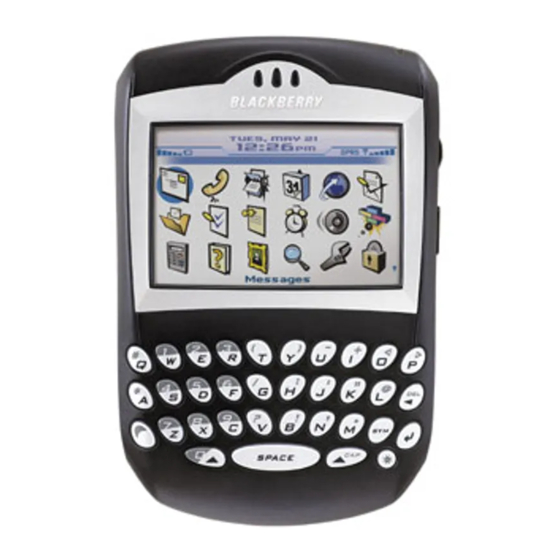Blackberry 7250 - MANUEL 4 Informações sobre segurança e produtos - Página 8
Procurar online ou descarregar pdf Informações sobre segurança e produtos para Portáteis Blackberry 7250 - MANUEL 4. Blackberry 7250 - MANUEL 4 10 páginas. Wireless handheld
Também para Blackberry 7250 - MANUEL 4: Manual de iniciação (13 páginas), Manual (19 páginas), Manual (12 páginas), Manual de iniciação (27 páginas)

Safety and Product Information Booklet
US Information Concerning the Federal Communications Commission
("FCC") Requirements for Hearing Aid Compatibility with Wireless Devices
Background Information
When wireless devices are used near hearing devices (such as hearing aids and cochlear implants), users may detect a
buzzing, humming, or whining noise. Some hearing devices are more immune than others to this interference, and
wireless devices also vary in the amount of interference they generate.
The wireless telephone industry has developed ratings to assist hearing device users in finding wireless devices that may
be compatible with their hearing devices. Not all wireless devices have been rated. Wireless devices that are rated will
have the rating displayed on their box together with other relevant approval markings.
The ratings are not guarantees. Results will vary depending on the user's hearing device and hearing loss. If your
hearing device is vulnerable to interference you may not be able to use a rated wireless device successfully.
Consulting with your hearing health professional and testing the wireless device with your hearing device is the best
way to evaluate it for your personal needs.
How the Ratings Work
M-Ratings: Wireless devices rated M3 or M4 meet FCC requirements and are likely to generate less interference to
hearing devices than wireless devices that are not labeled. M4 is the better/higher of the two ratings.
T-Ratings: Wireless devices rated T3 or T4 meet FCC requirements and are likely to be more usable with a hearing
device's telecoil ("T Switch" or "Telephone Switch") than unrated wireless devices. T4 is the better/higher of the two
ratings. (Note that not all hearing devices have telecoils in them).
Hearing devices may also be measured for immunity to this type of interference. Your hearing device manufacturer or
hearing health professional may help you find results for your hearing device. The more immune your hearing aid is,
the less likely you are to experience interference noise from wireless devices.
For additional information about the FCC's actions with regard to hearing aid compatible wireless devices and other
steps the FCC has taken to ensure that individuals with disabilities have access to telecommunications services, please
go to: www.fcc.gov/cgb/dro.
Industry Canada certification
This device complies with Industry Canada RSS 129, RSS 133 and RSS 210 under certification number 2503A-
RAR20CN.
Class B compliance
This device complies with the Class B limits for radio noise emissions as set out in the interference-causing equipment
standard entitled "Digital Apparatus," ICES-003 of Industry Canada.
Additional regulatory conformance
Specific details about compliance to the following standard and regulatory body may be obtained from Research In
Motion:
• Underwriters Laboratories UL60950 requirements for Canada and the United States
8
